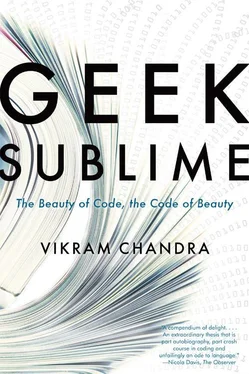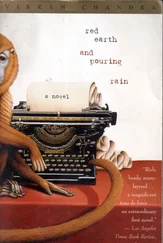The program you create in response to these requirements must reduce repetitive labor, automate the work that must be done each time, yet remain flexible enough to allow variation. The business practices that can be formalized into sets of procedures, into Grace Hopper’s dinner recipes — first do “a,” then “b,” then “c”—are easy to convert into code. In fact, the software practice that I learned in the eighties was called “procedural programming”—you wrote a program as a series of procedures that you called in sequence. Your job as a programmer was to “chunk” the system you were trying to model into clean, self-contained actions, and then construct more complex parts out of these simple elements. So, if you want to write a new report, what you do is: retrieve the doctor’s address, retrieve the patient’s information, create a new file. Or, in (pseudo) code: RetrieveDoctorsAddress(), RetrievePatientInfo(), CreateNewFile(). And these procedures would be called from BeginNewReport(). Which might be called from ShowApplicationMainMenu().
To engage in this kind of assemblage of functionality is bracingly logical and orderly; you feel like you are making a perfect little machine, a clean, comprehensible automaton that you have set in motion. But soon, as you adapt your procedural engine for the exceptions, for all the variations that exist in the real world, you find yourself snarled in squirming thickets of if-then-else constructs, each of which contains yet other if-elseif and switch-case monsters, and you find that you have to break out of your beautiful Report-Main-Body loop and backtrack to other reports to retrieve history, and then, inevitably your procedures become more complex and start doing two things instead of one, RetrievePatientInfo() is now doing the retrieving but is also checking for valid addresses, you know that functionality should be somewhere else but you don’t have the time to bother, the users ask for a new feature and you patch it in, and of course you mean to come back later and clean everything up, but then, before you know it, you are trapped inside an unwholesome, uncontrollable atrocity, a Big Ball of Mud: “[a] haphazardly structured, sprawling, sloppy, duct-tape and bailing wire, spaghetti code jungle.” 6
Often, it is not the lack of programming skill that leads to the emergence of a Big Ball of Mud, but something akin to the time-honored Indian practice of jugaad. Jugaad is Hindi for a creative workaround, a working improvisation that is built in the absence of resources and under pressure of time (from the Sanskrit yukti , trick, combination, concatenation). There can be something heroic about jugaad , as in the strange-looking trucks one sees bumping down country roads in rural India, which on closer examination turn out to be carts with diesel irrigation pumps strapped on; or the amphibious bicycles buoyed by improvised air floats and powered by blades taken from ceiling fans. Jugaad makes do, it gets work done, it maneuvres around uncooperative bureaucracies, it hacks. In recent years, jugaad has been recognized as down-to-earth creativity, as a prized national resource, and has acquired the dignifying sobriquet of “frugal engineering.”
In software, repeated applications of excessively frugal engineering by a series of programmers leads to a scheme that has no discernible structure, within which components use each other’s functionality promiscuously, so that the logic of the program becomes hard or impossible to follow. In a Big Ball of Mud — and yes, it is a technical term of art — effects flow across boundaries, so that introducing a small change to one piece of code results in unpredictable behavior in distant parts of the system. Software needs maintenance: bugs need to be fixed, new features are demanded by users. If you are the programmer asked to go into the depths of a Big Ball of Mud, the prospect is terrifying. I mean that quite literally; as you poke and prod into the innards of a badly written program on which users depend, you are often beset by paralyzing dread. How can you fix something you can’t understand? What if your fix introduces new bugs that reveal themselves in some future disaster which corrupts and loses data? The impulse then is to rewrite the whole program from the bottom up, in accordance with hard-won principles of good program design. But — often there is no budget for a complete rewrite, there is no time, there isn’t enough manpower. So maybe you patch a bit here, work in a clumsy kludge there— jugaad! Hundreds of programmers may have worked on such a program over the years, each contributing a little to the mess. So you add your handful of mud to the Big Ball, or maybe you just back away carefully and leave the damn thing alone. There are some areas of code in running programs that may as well be marked Here Be Dragons , and there are some programs that have run for decades — at universities, corporations, banks — that cannot be efficiently maintained or enhanced because nobody completely understands how they work.
For instance: the US Pentagon’s Defense Finance and Accounting Service (DFAS) is known to make “widespread” errors in paying soldiers’ salaries, and is slow to correct these mistakes when challenged. The software that the Pentagon uses for payroll and accounting comprises about seven million lines of COBOL code, mostly written in the sixties. The system hasn’t been updated in more than a dozen years, and significant portions of the code have been “corrupted”—long-running systems can suffer from “software entropy” or “code rot,” a slow deterioration in functionality because of the changing hardware or software environments they run within. A retired Pentagon employee reported that the system is “nearly impossible” to update because its documentation disappeared long ago: “It’s hard to make a change to a program if you don’t know what’s in there.” 7
When a situation like this becomes desperate enough, the powers-that-be may employ skilled “code archaeologists” to spelunk into the depths. Or pony up for a complete rewrite. Mostly, managers prefer to plug up the holes and leave the Big Balls of Mud to roll on. COBOL, a language first introduced in 1959 by Grace Hopper (“Grandma COBOL”), still processes 90 percent of the planet’s financial transactions, and 75 percent of all business data. 8You can make a comfortable living maintaining code in languages like COBOL, the computing equivalents of Mesopotamian cuneiform dialects. These ancient applications — too expensive to replace, sometimes too tangled to fix or improve — run on, serving up the data that appears on the chromed-up surface of your browser, which gives you the illusion that your bank and your local utility companies live on the technological cutting edge. But as always, the past lives on under the shiny surface of the present, and often, it is too densely tangled to comprehend.

The International Obfuscated C Code Contest annually awards recognition to the writer of “the most Obscure/Obfuscated C program”—that is, to the person who can produce the most incomprehensible working code in the language C. 9The stated pedagogical aim of the contest is “to show the importance of programming style, in an ironic way.” 10But it has always seemed to me that confronting unfathomable code is the programming equivalent of staring at the abject, of slowing down to peer into the carnage of a car wreck. This is the reason that programmers expend time and effort in designing esoteric, purposely difficult computer languages like the infamous “brainfuck”—that really is its official name, with the lowercase b —which was created as an exercise in writing the smallest possible compiler (240 bytes) that could run on the Amiga operating system. “Hello, world!” in brainfuck is:
Читать дальше













